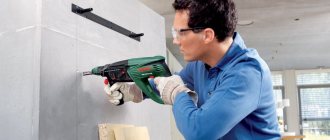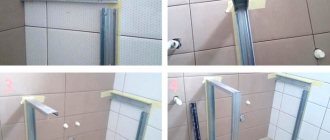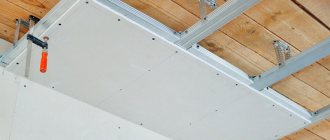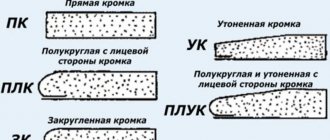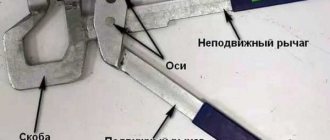MesterulManole
20898 0 4
MesterulManole October 28, 2016Specialization: many years of experience in finishing works of residential and office premises, summer houses, country cottages, etc. Hobby: cycling in all its forms
Aluminum battery on drywall - read on to learn how to hang it
Greetings. This time you will learn how to attach heavy objects to drywall. I hope the topic of the article will be of interest to many and there is a good reason for this. Finishing building surfaces with plasterboard is becoming increasingly widespread.
At the same time, you most likely will not be able to secure heavy objects to such a finish using traditional methods. So, how to fix certain objects on the surface of a sheathed gypsum board so that the result is durable and looks neat?
How to fix a massive object on a plasterboard wall
The “massive object” from the title can be not only a television panel, but also a painting in a heavy frame or, for example, a storage water heater that needs to be placed on the wall of the bathroom.
How it's done? Now we'll tell you! There are four main ways to place heavy objects on a false drywall wall. The first of them is to simply hang the object on special dowels designed for gypsum boards. The second is to assemble the shelf on brackets. The third is to organize a special niche for a heavy object. And finally, the fourth is to provide special embedded parts (for example, metal channels). We will now dwell on all these options in detail.
| “It’s not so easy to place something heavy on a gypsum board wall” |
So, the simplest option: there is only a sheet of drywall and nothing else. If we are faced with the task of hanging a modern TV, which usually weighs no more than 15-20 kilograms, it is quite possible to get by with simple drywall dowels (the so-called “butterflies” or “fishers”). The subtlety here is that such a dowel is designed to pierce both the sheet of drywall itself and the metal frame underneath (we are talking about a thin-walled profile, usually laid under the gypsum board). This means that when organizing fastening, you need to clearly remember in which places the frame goes behind the plasterboard sheet. It makes sense to mark places on the front side of the sheet. In addition, this approach assumes that we can decide in advance what and where to hang - otherwise the pitch of the frame may turn out to be completely inappropriate for placing anything.
If the idea of hanging came, as they say, after the fact, you can use other types of fasteners: for example, a “Molly” dowel or a self-tapping dowel. The latter can be made of nylon or metal (they are most often called “TT22” and “Driva”, respectively). Metal self-supporting drywall dowels are good for their extraordinary convenience - they are equipped with a drill at the end, which means they are simply screwed in without the use of additional tools for cutting the hole. They also hold up well, withstanding a load of up to 4 kilograms. If you need to exceed this limit, use dowels of the “Molly” type - so-called “umbrellas”, which open in the empty space behind the sheet and distribute the load over a sufficiently large area. These are the same dowels that are most often used to secure chandeliers to plasterboard ceilings. They are less convenient because they require additional drilling, and will not “work” if there is little free space between the rough wall and the gypsum board, but their load-bearing capacity is three or more times higher than that of “Driva”.
| “It’s not so easy to place something heavy on a gypsum board wall” |
But what to do if you need to load the wall even more? In this case, there is an option with long, massive coaxial dowels, which are fixed not in the sheet of drywall, but in the rough wall behind it. This option is suitable if the renovation has already been completed or is close to it, all the walls are covered with plasterboard sheets and no changes “from the inside out” are anymore acceptable. Of course, we assume that behind the sheet of drywall there is a concrete, brick or any other similar wall with a high load capacity. It should be taken into account that this does not always happen: for example, if there is a bathroom wall behind a plasterboard partition, it itself may well be a thin and very flimsy plaster partition. In many such cases, a niche or arch is provided for a heavy object, which can already be properly reinforced with frame elements. Another option (we listed it under the second number) is shelves on brackets that redistribute part of the vertical load over a large area of plasterboard sheet; It sounds scary, but in reality it’s quite trivial.
| “It’s not so easy to place something heavy on a gypsum board wall” |
If it is possible to prepare the front of the work in advance, it is better to provide special embedded parts under the drywall on which the load can be placed. Such embedded parts can be steel or aluminum corners or I-beams, as well as pipes that can be installed vertically and rested or even embedded in the floor. On such a reinforced frame it is possible to mount not only television panels, but also much heavier things - for example, storage water heaters weighing half a centner or more. The issue of fastening can be solved by cutting threads for mounting bolts in the embedded part. Instead of a metal structure, you can also use a wooden beam, although you will have to use screws instead of bolts. This design, as practice shows, can withstand very serious loads.
If for some reason it was not possible to make the frame embedded and hidden from view, it can be removed from the “finishing” side. True, in this case you will have to try to ensure that it matches the rest of the interior details or disguises it in some way (for example, with an additional false box).
MOLLY type anchor
Judging by the positive reviews from amateur users and finishing craftsmen, this anchor can only be called the king of gypsum core and the situation in general. When installing Baby Molly, you need to drill a hole of the same diameter as the sleeve. Further work with it is no different from previous models.
This anchor is almost universal, because the diameters in which it is presented on the market are numerous:
| Diameter, mm | Length, mm |
| 8 | 55 |
| 10 | 55 |
| 12 | 55 |
Opening an anchor sleeve is like solving the crime of an expansion rivet. However, here an important detail awaits us: the photo shows that the petals of the anchor sleeve press against the material so strongly that it is pressed through. You can avoid this by screwing in the bullet not with a screwdriver, but with a simple screwdriver.
Returning to the results of the experiment, we note that all approaches were on par. For example, the first failure occurred with a force of 92 lbs or 42.1 kg (force from the manufacturer 80 lbs - 36.3 kg).
The hole after the failure with torn edges is not that comparable, much larger than the diameter of the MOLLY anchor sleeve. The king is dead, long live the king!
| MOLLY | Break force, kg | Destruction (visual) |
| Information on the packaging | 36,3 | — |
| Experiment 1 | 42,1 | bad |
| Experiment 2 | 40,4 | bad |
| Experiment 3 | 39,0 | bad |
How do you attach anything to drywall? Drywall fastenings.
Drywall is an excellent building material that allows you to create various designs and achieve almost perfectly smooth surfaces. However, at the same time, it is quite fragile and attaching anything to its surface is very problematic. Conventional fastening methods using nails or screws become completely ineffective. Even objects of insignificant weight can tear out any self-tapping screw from drywall, leaving a gaping hole in its place.
Undoubtedly, the most durable and correct method of fastening to a plasterboard surface will be fastening using so-called “mortgages”. Moreover, before installing the drywall sheets, in places where it is planned to attach something in the future, a wooden beam or a strip of thick plywood is strengthened (laid). In the future, the “mortgage” block will bear the entire load, and fastening is carried out with the most ordinary self-tapping screw. However, experience shows that after installing the plasterboard sheets, various redevelopments are possible, or you simply want to hang another chandelier on the ceiling or another cabinet on the wall. Moreover, this attribute must be securely fixed in the drywall.
Various fastenings have been invented specifically for drywall. However, each has its own installation method and characteristics. Let's look at some of them.
Method 1. Fastening with a nylon or metal anchor.
Schematically, this mounting method looks like this:
1. First, screw the anchor into the drywall using a screwdriver; 2. We fix the object to be fixed using a self-tapping screw, which is usually included in the kit. This method of fastening is the simplest, since it does not require pre-drilling, and at the same time the weakest, because there is no fixation on the back side of the plasterboard sheet.
Method 2. Attachment using a drop-down metal anchor.
The fastening technology is as follows:
1. Insert the folded anchor into the pre-drilled hole; 2. Using a screwdriver, tighten the anchor with a screw. The folding anchor is fixed in a sheet of plasterboard, after which the screw must be unscrewed for further fastening; 3. Secure the item we need using a screw. You will first need to drill a hole in the item to be attached. This fastening method is quite strong, but requires a lot of effort and additional time spent unscrewing and re-screwing the screw to secure it.
Method 3. Attachment using a drop-down plastic anchor.
The mounting sequence is as follows:
1. Drill a hole of a suitable diameter (usually about 10mm); 2. Fold the anchor and insert it into the hole; 3. We secure the item we need using a self-tapping screw. At the same time, the anchor folds, providing fixation on the reverse side. 4. In a similar way, you can connect two sheets of drywall to ensure structural rigidity. This method of fastening can be considered the most durable, combined with the relative simplicity of its implementation.
Method 4. Fastening using a universal plastic dowel.
Installation is carried out in the following sequence:
1. Drill a hole of a suitable diameter; 2. Insert the dowel into the hole; 3. We secure the item we need using a self-tapping screw.
The dowel is folded into a knot, providing fixation on the reverse side. This method of fastening is quite simple, but not as reliable as the previous one.
Driva
Popular among drywall anchors and driva. Cheapness, ease of installation, and accessibility are important points when choosing fasteners, and these characteristics are inherent in this type of dowels. Driva are available in plastic and metal. Plastic (polyethylene) are more common, and they are cheaper. It is easy to attach the wood to a plaster wall. To begin, drill a hole with a diameter of 6 mm, insert the drive into it and, using a Phillips screwdriver, screw it in like a self-tapping screw until it stops. Due to the design, the drive is securely fixed in plaster, and according to the manufacturers, it can withstand a load of 25 kg or more. Still, you shouldn’t try to load like a molly. The cross-shaped hole is intended not only for fastening the dowel, but also a self-tapping screw is screwed into it, which should be selected correctly. Another advantage of these dowels is their short length (for plastic 23 mm, for metal - 33-44 mm), i.e. they practically do not require plaster space. This is where the need to select the length of the screw arises.
driva dowel
Attaching heavy objects to drywall
These methods of hanging heavy objects are quite reliable and easy to use. Depending on the situation, the following hardware is used: dowel - umbrellas, butterflies or moths. Characteristics of a butterfly dowel with dimensions But, there are factors in this fastening technology. Despite its versatility and a lot of positive characteristics, drywall has one specific feature: it is quite fragile under load. As a result, it is recommended to mount the material on a frame with an appropriate number of fixation points. An example of installing kitchen cabinets on plasterboard. Taking into account such factors, it is not always possible to use embeds. But, nevertheless, the inclusion of such parts in the design is mandatory when assembling plasterboard walls and installing partitions. You can hang a lot of very heavy objects on the anchor, for example, a boiler or a heating radiator, the weight of which is 80-100 kg or more. This is what anchor fasteners for drywall look like. Diagram with the names of elements for mounting on drywall. However, using dowels for drywall is an easier way to secure a heavy element than mortgages or anchors, especially with finished sheathing. At the same time, you most likely will not be able to secure heavy objects to such a finish using traditional methods. So, how to fix certain objects on the surface of a sheathed gypsum board so that the result is durable and looks neat. The advantage of mounting on fasteners without installing mortgages is that the method can be applied to an already used wall.
That is, if there is no immediate renovation of the room and there is no desire to dismantle the wall, this is the best option.
- After assembling the frame, select the location where you plan to install the item.
- Cut the bars according to the thickness of the guides between the profiles.
- Secure them using dowel nails or anchor bolts to the profiles or wall.
- From the side, connect the bars to the profile using self-tapping screws.
- Cover the frame with plasterboard.
In order to get into the bars, rather than into empty space, when hanging equipment, it is better to photograph them at the installation stage .
They usually have a size of 40x50 mm or 70x40 mm, depending on the metal frame.
No hangers
When creating a suspended ceiling, it is not recommended to skimp on hangers. Fastening without the use of hangers is often used when they want to install a frame on an uneven base; this temptation is especially great when working with wooden coverings.
As a result of such installation, the profile loses its mobility - due to shrinkage deformations, cracks may appear on the surface of the drywall. In addition, when rigidly fixed to the ceiling, the main advantages of a suspended structure are lost: the ability to level the surface, hide communications and additional insulation inside the ceiling.
Plasterboard ceilings are mounted on an anchor or direct suspension. Read more about installation methods in the article “Drywall - ceiling installation”.
How to hang a shelf and other heavy objects on drywall
The drywall screw is suitable for fastening light objects up to 3 kg; it can be screwed into drywall even without a dowel. A butterfly dowel , like a screw dowel, is designed for fastening objects of medium weight; with a single-layer sheathing it can withstand up to 10 kg, with a two-layer sheathing – up to 25 kg. The Hartmut dowel can withstand up to 35 kg with single-layer sheathing, and up to 55 kg with two-layer sheathing. The kit comes with a bolt; the plastic tendrils break off during installation.
The situation is familiar when there are walls made of plasterboard, no embeds have been made, but you need to hang a heavy object on the wall (shelf, TV, etc.) and the fasteners, as luck would have it, do not fit into the profile. Many people hesitate, considering drywall to be very fragile and unreliable, and in vain. Using the right fasteners, you can safely hang a heavy object on a plasterboard partition.
When attaching heavy objects to drywall, pay attention to the humidity in the room. Drywall that has absorbed moisture loses its rigidity and strength. The quality of the drywall itself is also of great importance; on the market you often end up with low-quality products on which I would not attach 30-50 kg.
Using profiles for other purposes
Each type of plasterboard profile has its own purpose. Sometimes a ceiling profile is used instead of a rack profile, this leads to the fact that the partition structure turns out to be fragile. In addition, this is associated with difficulties in work, since sheets cannot be attached to the ceiling profile on both sides. It is not recommended to bend profiles, cut or change their geometry.
This error is due to the fact that the use of ceiling profiles is allowed when covering walls or when creating boxes for shelves, a fireplace or a TV.
Ceiling profile partition.
Read more about the types of profiles for fastening drywall in the article “Profile for drywall: a brief educational program”
Fastening heavy objects to drywall: an overview of fasteners and how to use them
The problem is obvious, but there are simple and effective ways to solve it. If you need to hang something heavy on the wall, you can do it as follows: The combined option is used in cases where the dimensions of the mountings under the casing partially do not correspond to the location of the hinges on the equipment being mounted.
- Self-tapping screw for metal-to-metal plasterboard;
- Dowel “butterfly with self-tapping screw;
- Screw dowel with self-tapping screw;
- Dowel “umbrella with bolt;
- Hartmut dowel from Knauf with bolt.
What problems do installers face when they have to attach heavy objects to a plasterboard wall ?
- A hole with a diameter of 13 mm is drilled;
- A dowel with a folded spacer is inserted into the hole;
- The dowel is pulled back so that the spacer part from the inside is pressed against the sheathing;
- We secure the plastic part on the outside of the casing with a fastener and break off the excess;
- We screw in a bolt on which you can attach hanging loops or other hardware adapted for mounting a particular item.
Features of tongue-and-groove slabs
This material is inferior in density even to porous reinforced concrete. For construction purposes, GGP is valued for this property, since due to it the material demonstrates excellent thermal insulation. To understand, a PGP with a thickness of 8 cm in its thermal insulation capacity corresponds to a concrete wall with a thickness of 40 cm. That is, the use of such slabs allows you to save more free space.
In terms of sound insulation, the boards can meet regulatory requirements. The fragility of the GGP makes it easy to quickly cut the material. Therefore, in order to mount household appliances, furnishings, lamps or other items on the wall, you will need special dowels and fasteners.
How to attach to drywall
Important. If there are walls made of gas or foam concrete blocks, you should attach the embedded bars not to standard plastic dowels, but to special metal “crocodiles”. Ordinary ones simply won’t stick to fragile walls, and after a while the block, under the weight of the weight of the hung object, will come off the wall. But the most problematic question is how to attach a shelf to a plasterboard wall if the load-bearing surface is at a distance of 100 millimeters or more. Drywall fasteners Various types of shelves, lamps and chandeliers can be perfectly completed with a “butterfly” dowel.
The fastener itself is made of nylon. The ribs firmly fix it, which will prevent it from turning, and the side will prevent it from falling inside the walls. But the main thing is the design, which, when screwed in, opens into two halves in the form of wings, which rest against the drywall on the other side. The load is distributed and the mount is firmly secured.
This option is excellent for fastening large and heavy objects or plasterboard finishes. The main thing is to plan at the renovation stage where and what will stand and hang. Installation is carried out as follows: using a drill, a hole is punched in the drywall along the diameter of the dowel.
In the middle of the fastener slots, the wings are slightly bent and the screw is slightly tucked. Insert the fastener and screw it in until it stops.
Loose sand walls of old houses. Fastening methods.
June
2017
19
The sands of time flow and with this flow everything around us turns into sand. Today we’ll talk about “sand walls” in old houses, in fact, of course, this is not a squeak, more often it is either “shingles” or experimental materials based on gypsum, asbestos or other silicate-containing materials mixed in various proportions with various fillers to reduce the cost construction. This approach was popular not only during the construction of “Khrushchev” buildings, alas, and now in our time we often see unjustified ways to save money, I’m talking about modern partitions made of gas and foam blocks, because primarily these materials are intended for insulating external walls, but some for some reason they consider foam and gas blocks to be suitable materials for the construction of partitions. But now we are not talking about modern methods of constructing partitions, but about modern life in the conditions of old Khrushchev walls and partitions. The best way out of the situation is to demolish such a partition and rebuild it from solid brick, but when there are no funds for repairs, and life goes on, then you have to proceed from the current realities. But the reality is that old walls don’t hold up, dowels fall out of them, shelves and cornices tilt and fall. How do you attach a curtain rod or TV bracket to a sandy wall where you can't be sure it won't drop your plasma or the curtain rod won't fall on a child clinging to the curtain?
How to attach heavy objects to drywall
Sooner or later, you will want to drive a nail or screw into a plasterboard wall in order to hang a shelf, a picture, a panel, a mirror, acoustic systems, etc. This can be done without any problems, but must comply with certain requirements. Very often in any home you can find plasterboard structures. This material is of good quality and has a number of advantages.
Simple and convenient to install, the surface requires virtually no additional processing. This is why builders loved him. But this material also has disadvantages. Many who work with plasterboard often have a question about how to hang a heavy shelf or picture on a wall made of it, because from the weight all the parts can simply fall along with a piece of the wall.
A special “butterfly” dowel works great with drywall, which can be used to attach shelves, slats, chandeliers, cornices, antennas, etc. The dowel is made of high-quality polyamide (nylon). Longitudinal ribs protect the system from turning, and a locking edge protects the dowel from falling into the drilled hole. If you need an insulated balcony, then it’s difficult to do without drywall - it will help not only make the additional room warm, but also decorate the loggia in a modern, interesting style.
Construction foam must be poured into the empty area between the gypsum board and the load-bearing wall. It forms a dense area, which will strengthen the place where the cornice will be attached. After the foam has dried, you still need to get to the carrier with a drill and pour liquid dowel into it and the hole in the mounting foam.
Only after this can you safely attach the cornice to the wall.
Non-deforming drop-down MOLLY
A type of drywall anchor almost never found in the Russian Federation. The installation is the same as for a regular MOLLY, however, when tightening the bullet, the principle of operation of the cartridge case mechanism is slightly different. The bolt first pushes out the spacer, then tightens it.
Anchor dimensions:
| Diameter, mm | Length, mm |
| 8 | 55 |
| 10 | 55 |
| 12 | 55 |
The last contestant performs very well. The first stall force was 163 lbs or 73.9 kg, compared to the manufacturer's standard of 100 lbs or 45.4 kg.
We believe that the dismantling hole does not need any comments.
| MOLLY folding | Break force, kg | Destruction (visual) |
| Information on the packaging | 45,4 | — |
| Experiment 1 | 73,9 | bad |
| Experiment 2 | 84,4 | bad |
| Experiment 3 | 85,7 | bad |
Tips and tricks from experienced builders
Recommendations on how to secure the dowel part in the wall correctly:
- Pre-clean the funnel where you will insert the self-tapping screw.
- The hole must be deeper than the length of the dowel.
- If the wall is fragile, before installation, wet the plastic part of the fastener with glue.
- If there are voids in the wall, it is advisable to use butterfly fasteners.
- It is advisable to drill the funnel at a slight angle, tilting the drill towards the floor.
- It is advisable to use new drills of the same diameter as the dowel.
- During installation, if complications arise, the fasteners are removed and a wire is used to check what prevents it from going deeper.
- Select fasteners according to the type of wall.
Previous post How to repair a laptop lid mount Next post Installing a hob
Fischer UX universal dowel, nylon
Purpose. UX is a universal nylon dowel. It is used in attaching curtain rods, picture rails, baskets, motion detectors, mailboxes, lamps, lightweight mirrors, baseboards, towel holders, lightweight shelves and electrical switches. Design features. The UX nylon dowel has a special toothed locking element that prevents the dowel from twisting. Principle of operation. When a screw is screwed into the UX universal nylon dowel, the teeth of the dowel expand and are securely fixed in the surface. Fastening material. The UX dowel is made of nylon. Base material. The universal nylon dowel UX is suitable for use in concrete. It can also be used in plasterboard, fiberboard, chipboard, gypsum fiber board, in hollow concrete blocks, in hollow lightweight concrete blocks, in natural stone with a dense structure, in sand-lime solid bricks, in bricks with vertical voids, in solid lightweight concrete blocks. Installation. To install the UX dowel, you need to drill a hole in the surface. Then insert the dowel into it and screw the screw into it. In aerated concrete and hollow bricks, drilling must be carried out in rotation mode. It is prohibited to use a universal nylon dowel for attaching suspended products to the ceiling. For through-hole installation, a screw of the maximum diameter must be used.
What is a classic dowel?
The classic dowel for concrete and other solid materials has been preferred by specialists in the field of construction and repair for a long time. Consumers often call it a “dowel-nail.” Concrete fasteners can be made of metal, nylon and various types of plastic. Naturally, products made from different materials differ in their characteristics and, accordingly, in their area of application.
Polypropylene dowel-nail with a hidden side
The load-bearing capacity of a dowel on concrete is determined by its design features. In the classic design, a dowel-nail is a sleeve, the entire outer surface of which has special notches that prevent such an element from turning in a hole in a wall or in any other building structure. Special whiskers, which, due to their elasticity, are constantly in a decompressed state, help prevent the fastening element from being pulled out of the wall. When a screw is screwed in, the fastening element expands due to longitudinal slots on its surface, which ensures high reliability of its fixation.
Parameters of dowel-nails with a mushroom-shaped edge used for through installation (click to enlarge)
In addition to dowel fasteners, which operate on a mechanical principle, the modern market offers dowels for porous concrete and other similar materials, fixed in the holes through the use of a special adhesive composition. By filling the internal cavities of the porous material, the adhesive composition reliably fixes such an anchor element in a previously prepared hole.
The classic dowel-nail intended for concrete is such a universal fastener that it is quite difficult to list all the areas of its application. With its help, they install frames for various purposes, attach furniture and interior items to the surface of walls, fix household appliances at the required installation location, and also solve a whole list of other important tasks.
Metal driven dowel nails can be made of steel or aluminum alloys
